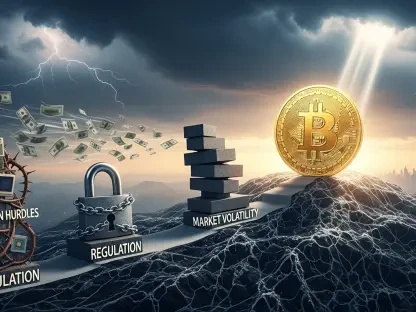As we inch closer to 2025, the payments industry is set to undergo significant transformations, driven largely by consumer preferences and advancements in technology. A recent survey conducted by payabl has shed light on the dramatic shifts in the payment landscape, emphasizing the increasing prominence of digital wallets and Open Banking. Merchants are already gearing up to meet these evolving demands by heavily investing in technology and rethinking their payment strategies to stay ahead in the game. These changes not only promise greater convenience but also aim to provide enhanced security, efficiency, and flexibility in handling transactions.
Digital wallets are expected to see substantial adoption, with 81% of merchants foreseeing a rapid increase in their usage. This anticipation stems from the growing consumer demand for seamless and secure payment options. Similarly, Open Banking is expected to gain traction, with 69% of merchants predicting its rise due to the popularity of instant bank transfers. Additional emerging payment methods, such as QR code payments, Buy Now, Pay Later (BNPL) options, cryptocurrencies, and Central Bank Digital Currencies (CBDCs), are set to further diversify the payment ecosystem. These innovations are primarily driven by consumers’ desire for convenience, technological advancements, and evolving regulatory landscapes.
Surge in Digital Wallet Adoption and Open Banking
Digital wallets have emerged as a game-changer in the payments industry, offering users the ease of storing card information and making transactions swiftly and securely. With 81% of merchants anticipating a rise in digital wallet adoption, it is evident that this trend is here to stay. Consumers increasingly favor digital wallets for their convenience, enabling quick and contactless payments that align with the fast-paced digital world. Additionally, the security features provided by digital wallets, such as encryption and biometric authentication, are appealing to users who seek safe transactions.
Open Banking is poised to revolutionize the payments landscape by facilitating instant and seamless bank transfers. With 69% of merchants predicting its rise, Open Banking promises to enhance user experiences by offering direct access to bank accounts for faster and more efficient transactions. This trend is particularly gaining momentum due to the increasing popularity of instant payments, which provide an immediacy that traditional payment methods often lack. The regulatory push for Open Banking is also contributing to its growing adoption, as it encourages competition and innovation within the financial sector.
Technological Investments and Their Impact
To stay competitive in the rapidly evolving payments ecosystem, merchants are prioritizing significant investments in technology. A noteworthy 65% of merchants plan to implement artificial intelligence (AI) to enhance real-time fraud detection and improve the overall performance of their payment systems. The use of AI in fraud detection is particularly crucial, as it enables the identification and prevention of fraudulent activities before they can cause significant harm. This proactive approach not only builds consumer trust but also ensures the integrity of payment transactions.
Moreover, 56% of merchants are leveraging data analytics to gain valuable insights into payment behaviors. By analyzing data patterns, merchants can better understand consumer preferences and tailor their payment strategies accordingly. Data analytics also play a pivotal role in identifying potential bottlenecks and optimizing payment processes for smoother transactions. Another significant technological investment is in API-based integrations, with 38% of merchants focusing on creating secure and flexible ecosystems. APIs facilitate seamless communication between different systems, enhancing the overall efficiency and security of payment processes.
Challenges and Regulatory Considerations
Despite the promising advancements in the payments industry, merchants face significant challenges, with fraud prevention topping the list of concerns for 63% of respondents. As the payment landscape evolves, so do the tactics employed by fraudsters, necessitating robust security measures to protect consumers and businesses alike. Regulatory compliance is another major challenge, with 60% of merchants expressing concerns about keeping up with the rapidly changing regulatory environment. Navigating through complex regulatory frameworks requires merchants to stay updated and adapt their strategies to remain compliant.
Cybersecurity risks are also a pressing issue, highlighted by 46% of respondents. The increased digitization of payment processes has made systems more vulnerable to cyber-attacks, requiring merchants to invest in advanced security measures to safeguard sensitive information. Additionally, integrating AI into payment systems poses its own set of complexities, as noted by 44% of respondents. Ensuring that AI systems function effectively while minimizing risks is a delicate balance that merchants must strike. Lastly, cross-border payments present a challenge for 10% of respondents, emphasizing the need for streamlined processes to facilitate international transactions.
Looking Ahead: Future Trends and Preparations
As we approach 2025, the payments industry is poised for significant changes, propelled by consumer preferences and technological advancements. A recent survey by payabl highlights the evolving payment landscape, with digital wallets and Open Banking on the rise. Businesses are preparing to meet these demands by investing heavily in technology and revising their payment strategies to stay competitive. These changes promise to enhance convenience while improving security, efficiency, and transaction flexibility.
Digital wallets are projected to see wide adoption, with 81% of merchants expecting a swift increase due to the growing demand for seamless and secure payment options. Open Banking is also anticipated to gain traction, with 69% of merchants predicting its rise, driven by the popularity of instant bank transfers. Other emerging payment methods, such as QR code payments, Buy Now, Pay Later (BNPL) options, cryptocurrencies, and Central Bank Digital Currencies (CBDCs), are further diversifying the payment ecosystem. These innovations are primarily fueled by consumers’ demand for convenience, technological progress, and changing regulatory environments.









